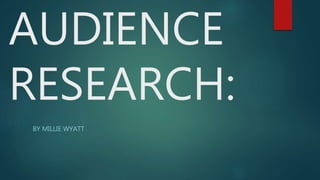
Hierarchy of needs
- 2. Hierarchy of Needs: • An American psychologist called Abraham Maslow created the Hierarchy of Needs which can be represented in a five tier pyramid. The lower down tiers have to be satisfied for the individual to be able to reach the highest tiers. • The lowest tear is called ‘psychological’ which represents the essentials which humans need to survive. E.g. Food, water, shelter, sleep and clothing. • The penultimate level is ‘safety’ which encompasses the elements of safety and security around health, physically and financial safety. • The middle tier is called ‘Love/belonging’ which is about social relationships and connections which a human needs or wants to feel like they belong. • The second level is called ‘Esteem’ and this is achieved by success and progress in endeavours and can also be described as being perceived well and respected by others. • The top tier is ‘Self-actualization’ which is the highest level of the triangle as it is a realisation of an your own potential which is gained through the experience of he other levels.
- 3. Passive audiences and hypodermic needle theory: In the 1920s Harold Laswell originated the hypodermic needle theory which impresses ideas and thoughts onto audiences of a more passive and susceptible nature. The more passive audiences are more commonly naive and vulnerable to media propaganda. The theory suggests a lack of resistance against the media as passive audiences will take these ideas and act upon them which could possibly be dangerous. This theory expresses the idea that the world of media has enormous amounts of power over groups of people. An example of this is the Redbull adverts which promote and sponsor activities such as cliff jumping which can be viewed as dangerous. The passive audiences are being injected with these ideas which they may carry out. They are seeking a higher social standing as they are being fooled into believing that drinking Redbull will give them the capability to cliff jump for example.
- 4. Passive Audiences: Passive audiences are perceived to be people who are easily influenced by surrounding ideas. For example the media is able to plant ideas into their heads through propaganda. These people are open-minded in the way that their opinions are easily changed and influenced.
- 5. Cultivation Theory: Cultivation theory is the theory which also presents the audience as passive as well as the hypodermic needle theory. It infers that the audience can be influenced when they are exposed to the same message over and over again. The more someone listens to something, the more it is embedded in their brain. As an example, exposure to more violent scenes in movies can result in people behaving more violently as they are more numb to viewing violence as irregular or extreme. This can be opposed as there is no evidence to prove that people react any different each time they watch a similar genre of film. For example, if you watch a horror/thriller with jump- scares, audiences do not become numb to them as it is a natural reaction to be shocked.
- 6. Two step flow theory: The two step flow theory explains the two categories that the media’s influence can be put into. Category 1: The information does not go directly into the minds of the audiences. It is passed on through the people who have opinions in the audience which they then communicate to the people around them who could be people who are considered part of the passive audience who then inject those views themselves. Category 2: This means that the media can be viewed as less threatening because their information is being filtered which gives the audience with opinions more power.
- 7. Active audiences: The active audience theory suggests that audiences do not receive the information passively but rather take it on in an active way. This could be done by taking it into conversations. Through doing this, the audience are taking in their own personal information and context of their lives to fit the ideas and information into what they do. This is a more modern theory which is the most common way of referring to an audience.
- 8. Uses and gratification mode: The mode of gratification suggests that audiences consciously take in information based around their cultural and social preferences. They also add in their personal needs. This goes off the idea that audiences chose the text which they feel is best suited to them and their needs as they know what they want from media. They can chose to watch materials to influence their moods in a positive way such as watching happy material or scary material.
- 9. Reception Analysis: This analysis focuses on how audiences interact with a media text in relation to their lives in a more personal context. In 1974 it was created by Professor Stuart Hall and Charlotte Brunsden with additional research done later by David Morley. Experiences affect the way that people receive media as an audience. There are 3 ways which Professor Stuart Hall thinks media can be received: 1. Dominant: This way is where a person is received in an unproblematic and simple way. 2. Negotiated: They accept the intended message to an extent but they interpret it in a way that suits their own views and lifestyle. 3. Oppositional: When the viewer understands the meaning but does not agree with it personally and therefore rejects it.
- 10. Interactive audiences: Interactive audiences are the people who develop greater understandings of media by interacting with the information given. This creates a link between the media and the person. An interactive audience happens when they are able to access further forms of information which aren’t necessarily broadcasted by the producer. For example, Instagram, Websites and YouTube videos about Media.